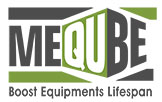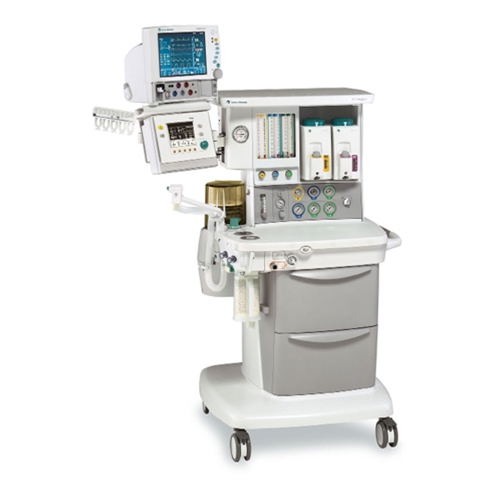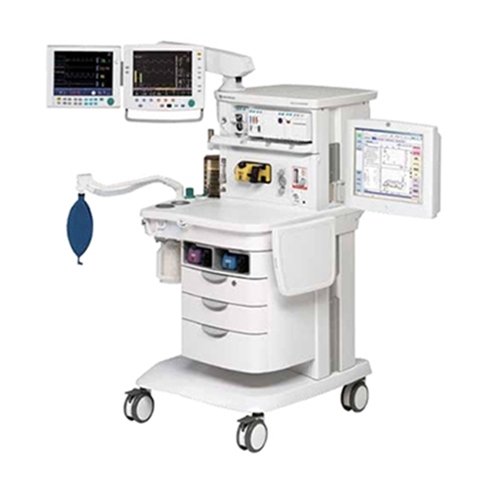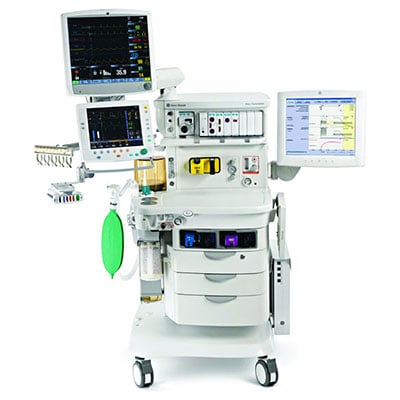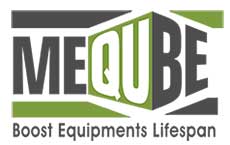Showing all 3 results

GE AESPIRE 7100
GE AESPIRE 7100
Features
The S/5 Aespire marks the introduction of the new Advanced Breathing System, the ABS™. Its design, based on your needs, is fully integrated into the workstation. Fewer parts and connections reduce the potential for leaks and misconnects, providing greater patient safety. Multi Absorber* canister facilitates fast, easy removal and replacement. Fully autoclavable, integrated electronics detect complete engagement or disengagement of the ABS. One step mechanical bag to vent switch requires no electronics.
Soma Tech Intl offers two different ventilator options in the GE Datex Ohmeda S/5 Anesthesia Machine. The GE Aespire can either have a 7100 ventilator or a 7900 ventilator. Both of these ventilators are microprocessor-based, electronically-control, and pneumatically-driven. The S/5 Aespire’s ventilators have built-in monitoring for inspired oxygen, airway pressure, and exhaled volume. These ventilators are designed to be used to aid in the delivery of anesthesia and are part of the GE Datex Ohmeda S/5 Aespire anesthesia machine.
7900 and 7100 Ventilator Safety Features
- Dual redundant airway overpressure protection.
- Volume over-delivery limits and protection.
- Proprietary hose connections and fixed manifolds.
- 10 VA electrical power limiting to potential oxygen enriched environment.
- 150 psi burst overpressure protection.
Ventilator Monitoring Boards
The 7100 ventilator is accompanied by a Ventilator Monitoring Board (VMB) which serves as the interface between the ventilator’s control board and the breathing system sensors and switches. It passes different switch functions through to the ventilator control module and provides power to the task light. Respiratory gas flow, to and from the patient, is monitored by measuring the differential pressure across a variable orifice in each flow sensor. The pressure transducers measure the differential pressure on the VMB.
The 7900 ventilator is equipped with an Enhanced Sensor Interface Board (ESIB) which is located under the tabletop. The ESIB serves as the interface between the ventilator CPU board and the breathing circuit sensors and several machine switches. It passes through various switch positions to the ventilator CPU board and provides an interface for the ACGO switch, the Bag/Vent switch, the canister release switch, control panel cover switch, CO2 bypass switch, and breathing circuit ID switches.
Ventilator Batteries
Both the 7100 and the 7900 ventilators on the S/5 Aespire have a sealed lead acid battery that is only used as back up power in case of power failure. The batteries will power each unit for about 30 minutes.
GE Datex Ohmeda S/5 Aespire Anesthesia Machine Features
- Power up is quick and easy in your fast-paced environment.
- Minimum 02 flow of 50 mL available with dual flow tubes, ensures accuracy in low flow situations.
- Enhanced hose and cable management reduces disconnects and clutter.
- Lightweight and compact for easy maneuverability.
- Larger work surface for supplies and chart.
- Two large drawers provide more storage.
- Removable drawer insert conveniently stores small items.
- Smooth, durable surfaces for cleaning ease.

GE AESPIRE 7900
GE AESPIRE 7900
Features
The GE Datex Ohmeda Aespire View is compact, durable, with easy to clean surfaces. It comes with a 12-inch ventilation display that showcases waveforms and alarm indicators. The Aespire offers both anesthesia gases and ventilation at the same time. The Aespire View uses the GE SmartVent 7900 as the ventilator system for the anesthesia machine. The ventilation system makes it easy to minimize the space in the ICU or operating room by combining the Ventilator and the anesthesia machine in one. The Aespire View also comes standard with GE’s advances Breathing System (ABS). This allows the anesthesia machine to work with low circuit volumes as well as low flow anesthesia.
- Small breathing system volume rapidly response to fresh gas changes with the ABS (Advanced Breathing System).
- Fewer parts to help prevent unwanted disconnects and leaks.
- Bag-to-vent switch works without electronics in case of power failure.
- Autoclavable and latex-free surfaces.
- Optional EXChange and condenser.
- Extra large work surface area.
- Two storage drawers.
GE AISYS
GE AISYS
Features
The Aisys Carestation for anesthesia is a scalable, flexible, and functionally integrated system, featuring advanced design ventilation, respiratory monitoring, and breathing system. The Aisys Carestation simplifies complex processes with its innovative design. The large-panel displays are mounted on a movable arm with 360° of rotation. You can easily reposition the displays to keep vital signs and ventilation controls in view and in reach at all times.
- Ventilation, vaporization and gas delivery are electronically controlled and monitored.
- Data capabilities enable digital interfacing of patient and Carestation information.
- The GE Aisys software is easily upgradable to enhance the functionality, add support, and enhance data management.
- Provides digital feedback on ventilation, drug levels, patient status, and fresh gas usage.
- Ventilation Modes Include PCV-VG, pressure control, PSVPro, volume control, SIMV, and manual ventilation.
- Flexible 7900 SmartVent technology is suitable for neonates, pediatric, cardiac compromised, and standard cases.
- Built in ABS allows for low circuit volume, which creates a fast response, and optimizes low-flow anesthesia.
- Digital vaporization includes continuous monitoring by multiple embedded sensors to help ensure precise delivery.
- Digital agent control provides data record keeping of set agent concentrations and usage calculations along with audible low agent alarm alerts.
- Electronic protocols provide data continuity.
- Rising multi-breath bellows provide a visual feedback mechanism for the patient condition.
- Smartvent display conveniently compares flow, volume, and pressure data over time.
- Electronic ventilation provides a full assessment of the patient’s status. The ventilator is able to distinguish between mechanical and spontaneous breathing.
Exceptional Design
- Flexible and integrated, with the most advanced design, ventilation, vital signs monitoring and Advanced Breathing System (ABS™)
- Exclusive INview™ Patient Displays so that you can position the patient and ventilation data and controls where you need them
- Can be integrated with your hospital information system
- Fully upgradeable to add new technologies as your needs change
Proven Clinical Excellence
- Superior ventilation for neonates to adults
- VCV (Volume Control) Cardiac Bypass, Volume Control, Pressure Control, PSVProR (Pressure Support with Apnea backup), Synchronized Intermittent Mandatory Ventilation (SIMV) – Volume and Pressure, electronic PEEP, PCVVG (Pressure Controlled Ventilation – Volume Guaranteed) (Optional)
- Tidal volume compensation
- Vital signs monitoring with our exclusive technology (Optional)
- Patient Spirometry™ measures airway pressures, flow, volumes, compliance and airway resistance, breath by breath at the patient’s airway.
- Entropy aids you in monitoring the state of the central nervous system
- Neuromuscular transmission (NMT) provides a continuous, quantitative measurement of patient’s responses to nerve stimulation and regional block
- Advanced Breathing System (ABS)
- Fewer connections reduce the risk of misconnects and leaks, enhancing patient safety
- Low circuit volume contributes to a fast response— ideal for low flow cases
- Rising, microprocessor-controlled bellows provides immediate visual feedback about the patient’s status
